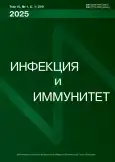Анализ временных рядов для моделирования и прогнозирования подтвержденных случаев гриппа а в Алжире
- Авторы: Себа Д.1, Бенаклеф Н.2, Белаиде К.2
-
Учреждения:
- Высшая школа информатики
- Университет Беджаи
- Выпуск: Том 15, № 1 (2025)
- Страницы: 168-172
- Раздел: КРАТКИЕ СООБЩЕНИЯ
- URL: https://bakhtiniada.ru/2220-7619/article/view/292140
- DOI: https://doi.org/10.15789/2220-7619-TSA-17693
- ID: 292140
Цитировать
Полный текст
Аннотация
Грипп А является подтипом вируса гриппа, который в первую очередь поражает птиц и млекопитающих, вызывая респираторные заболевания, и характеризуется способностью быстро мутировать, что приводит к появлению разнообразия штаммов и периодическим пандемиям. Настоящая статья посвящена изучению в Алжире распространения и прогнозированию подтвержденных случаев гриппа А, высокоинфекционного заболевания, которое вызывает широко распространенные заболевания и смертность как в Алжире, так и во всем мире. Материалы и методы. Для прогнозирования подтвержденных случаев гриппа А были применены несколько статистических моделей, включая ARIMA, Seasonal ARIMA (SARIMA), ETS, BATS и широко признанный метод машинного обучения RNN. Далее мы провели сравнительное исследование с использованием показателей производительности для оценки указанных моделей. Результаты. Для определения наиболее эффективной модели проводилась оценка среднеквадратической ошибки. Наши результаты показывают, что RNN превзошел другие модели благодаря своей способности обрабатывать сложные шаблоны, включая сезонные компоненты и наличию памяти. SARIMA и BATS также показали хорошие результаты благодаря своей способности управлять сезонными закономерностями. Напротив, ARIMA и ETS показали самые плохие результаты. Вывод. В приводимом исследовании использовался комплексный подход для разработки модели прогнозирования подтвержденных случаев гриппа A в Алжире. Полученные результаты расширяют наше понимание потенциального будущего распространения данного заболевания и способствуют эффективным стратегиям управления рисками.
Ключевые слова
Полный текст
Открыть статью на сайте журналаОб авторах
Джиллали Себа
Высшая школа информатики
Автор, ответственный за переписку.
Email: d.seba@esi-sba.dz
Doctor in Mathematics, Assistant Professor, Laboratory of Applied Mathematics, Department of Mathematics
Алжир, г. Сиди-Бель-АббесН. Бенаклеф
Университет Беджаи
Email: d.seba@esi-sba.dz
аспирант по математике, специальность «Вероятность и статистика», лаборатория прикладной математики в Университете
Алжир, г. БеджаяК. Белаиде
Университет Беджаи
Email: d.seba@esi-sba.dz
д.мат.н., профессор, лаборатория прикладной математики, факультет математики
Алжир, г. БеджаяСписок литературы
- Ali S.T., Cowling B.J. Influenza virus: tracking, predicting, and forecasting. Annu Rev. Public Health, 2021, vol. 42, pp. 43–57. doi: 10.1146/annurev-publhealth-010720-021049
- Al-Qaness M.A.A., Ewees A.A., Fan H., Abd Elaziz M. Optimized forecasting method for weekly influenza confirmed cases. Int. J. Environ. Res. Public Health., 2020, vol. 17, no. 10: 3510. doi: 10.3390/ijerph17103510
- Boostani R., Rismanchi M., Khosravani A., Rashidi L., Kouchaki S. Presenting a hybrid method in order to predict the 2009 pandemic influenza A (H1N1). J. Health. Med. Inform., 2012, vol. 3, no. 1, pp. 31–43. doi: 10.4172/2157-7420.1000112
- Cheng H.Y., Wu Y.C., Lin M.H., Liu Y.L., Tsai Y.Y., Wu J.H., Pan K.H., Ke C.J., Chen C.M., Liu D.P., Lin I.F., Chuang J.H. Applying machine learning models with an ensemble approach for accurate real-time influenza forecasting in Taiwan: development and validation study. J. Med. Internet Res., 2020, vol. 22, no. 8: e15394. doi: 10.2196/15394
- De Livera A.M., Hyndman R.J., Snyder R.D. Forecasting time series with complex seasonal patterns using exponential smoothing. J. Am. Stat. Assoc., 2011, vol. 106, no. 496, pp. 1513–1527. doi: 10.1198/jasa.2011.tm09771
- Feradi F., Bouhata R., Kalla M.I., Kalla M. Assessing avian influenza vulnerability using geographically weighted regression, Batna Algeria. The Arab. World. Geographer, 2023, vol. 26, no. 1, pp. 76–87. doi: 10.5555/1480-6800-26.1.76
- Goldstein E., Cobey S., Takahashi S., Miller J.C., Lipsitch M. Predicting the epidemic sizes of influenza A/H1N1, A/H3N2, and B: a statistical method. PLoS Med., 2011, vol. 8, no. 7: e1001051. doi: 10.1371/journal.pmed.1001051
- Kandula S., Yamana T., Pei S., Yang W., Morita H., Shaman J. Evaluation of mechanistic and statistical methods in forecasting influenza-like illness. J R Soc. Interface, 2018, vol. 15, no. 144: 20180174. doi: 10.1098/rsif.2018.0174
- Khan M.A., Abidi W.U.H., Ghamdi M.A.A., Almotiri S.H., Saqib S., Alyas T., Khan K.M., Mahmood N. Forecast the influenza pandemic using machine learning. Comput. Mater. Contin., 2021, vol. 66, no. 1, pp. 331–340. doi: 10.32604/cmc.2020.012148
- Lu Y., Wang Y., Shen C., Luo J., Yu W. Decreased incidence of influenza during the COVID-19 pandemic. Int. J. Gen. Med., 2022, vol. 15, pp. 2957–2962. doi: 10.2147/IJGM.S343940
- Mejia K., Viboud C., Santillana M. Leveraging Google search data to track influenza outbreaks in Africa. Gates Open Research, 2019, vol. 3, no. 1653: 1653. doi: 10.12688/gatesopenres.13072.1
- Seba D., Belaide K. Forecasting infection fatality rate of COVID-19: measuring the efficiency of several hybrid models. Russian Journal of Infection and Immunity, 2024, vol. 14, no. 2, pp. 313–319. doi: 10.15789/2220-7619-FIF-17548
- Wolk D.M., Lanyado A., Tice A.M., Shermohammed M., Kinar Y., Goren A., Chabris C.F., Meyer M.N., Shoshan A., Abedi V. Prediction of influenza complications: development and validation of a machine learning prediction model to improve and expand the identification of vaccine-hesitant patients at risk of severe influenza complications. J. Clin. Med., 2022, vol. 11, no. 15: 4342. doi: 10.3390/jcm11154342
- Xu Q., Gel Y.R., Ramirez Ramirez L.L., Nezafati K., Zhang Q., Tsui K.L. Forecasting influenza in Hong Kong with Google search queries and statistical model fusion. PLoS One, 2017, vol. 12, no. 5: e0176690. doi: 10.1371/journal.pone.0176690
- Xue H., Bai Y., Hu H., Liang H. Regional level influenza study based on Twitter and machine learning method. PLoS One, 2019, vol. 14, no. 4: e0215600. doi: 10.1371/journal.pone.0215600
- Zheng Y., Wang K., Zhang L., Wang L. Study on the relationship between the incidence of influenza and climate indicators and the prediction of influenza incidence. Environ. Sci. Pollut. Res. Int., 2021, vol. 28, no. 1, pp. 473–481. doi: 10.1007/s11356-020-10523-7










